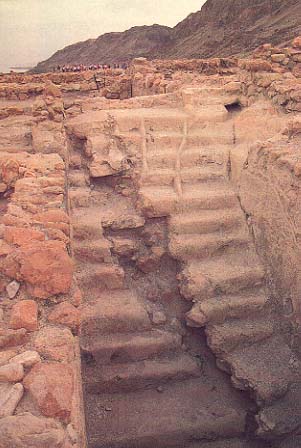Image Details

Hershel Shanks
Fractured by an earthquake in 31 B.C., steps about six feet wide lead into a large, heavily plastered miqveh. Built by the Essenes at Qumran in the second century B.C., the roofless pool was originally identified as a cistern for this Judean Wilderness community.
But why would the Essene hydraulic engineers have built such wide steps in a water storage tank, when narrow ones along one side would have taken up a smaller part of the tank’s volume? The answer is that these steps provided access not to an occasional cistern maintenance worker, but to numerous bathers using the ritual pool on a regular basis.
Remains of two parallel partition walls are evident on the upper steps. These walls may have created a central water channel flanked on either side by dry entrance and exit stairs.
